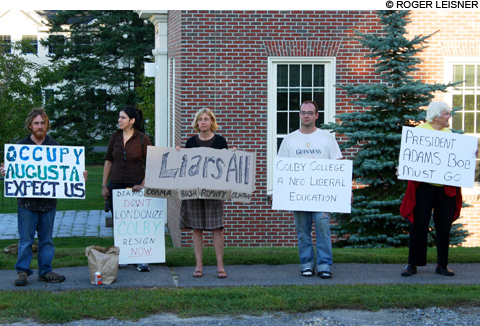
OUTSIDE THE DIAMOND BUILDING Occupy Augusta protesters and others object to disgraced banker Bob Diamond’s donations to Colby College. |
As the first anniversary of Occupy approached, many journalists wrote its obituary, and some called it a failure. But Occupy Augusta is alive and kicking the One Percent. A September 12 protest by the group at Colby College in Waterville — the second there on the same theme — challenged a rarely challenged practice: accepting money from rich people for a good cause.
Colby's response showed how deeply dependent good causes are — in this case, a highly-respected liberal-arts college — on the generosity of the rich.
Even when the rich may have obtained their money corruptly.
The occasion for the protest was a speech, "Will there be an Occupy 2.0?," by Columbia University sociology and journalism professor Todd Gitlin, author of the new book Occupy Nation: The Roots, the Spirit, and the Promise of Occupy Wall Street.
Gitlin said he didn't presume to know the future of Occupy. But between his spoken lines it was clear he agreed with Augusta occupier Lew Kingsbury, who told the Phoenix: "Encampments are a thing of the past. Issue-specific protests are the future."
Indeed, notwithstanding first-anniversary street protests in New York, many occupiers already are turning from headline-grabbing confrontations to strengthening reformist politics — joining efforts to forgive student debt, halt home foreclosures, or reduce corporate money flowing to politicians.
KEEPING THE RADICAL BLAZE BURNING
But for a couple of hours before Gitlin's speech, a more original and, therefore, more typically Occupy action was on display in Waterville. It wasn't original in tactics — picketing and leafleting — but in target: the deep penetration of the corrupt rich into philanthropy.
Twenty Occupy Augusta veterans stood with their signs (e.g., "Colby College — a Neo-Liberal Education") outside the campus's sparkling new Diamond Building, which contains the economics and other social-science departments. They were demonstrating against Colby's intimacy with the building's funder, Bob Diamond, the extremely wealthy, disgraced former CEO of the giant British bank Barclays and chairman of the Colby board of trustees.
Until he was forced to resign this summer, Diamond, an American whom news reports identify as a top fundraiser for GOP presidential candidate Mitt Romney, took home pay and bonuses in the tens of millions annually while he led Barclays as it helped rig the most important bank interest rate in the world, called LIBOR. Meanwhile, he gave millions to Colby.
The protesters — organized by Kingsbury, who graduated from Colby in 1977, four years after Diamond — demanded the college remove his name from the building, stop taking his money, and remove him from the board.
"You wouldn't put Al Capone's name on a building," said Kingsbury. He felt Colby's embrace of Diamond sends a rotten ethical message to students.
Gitlin, a veteran of '60s radicalism, allied himself with the protesters. His speech, held in the student center, drew about 100 students, faculty, and activists.
He said academia has engaged in an "exaltation of wealth." He mentioned that a hedge-fund manager (J. Ezra Merkin) connected to mega-crook Bernie Madoff had bought naming rights to a classroom Gitlin taught in at Columbia.
COLBY DEFENDS ITS BENEFACTOR